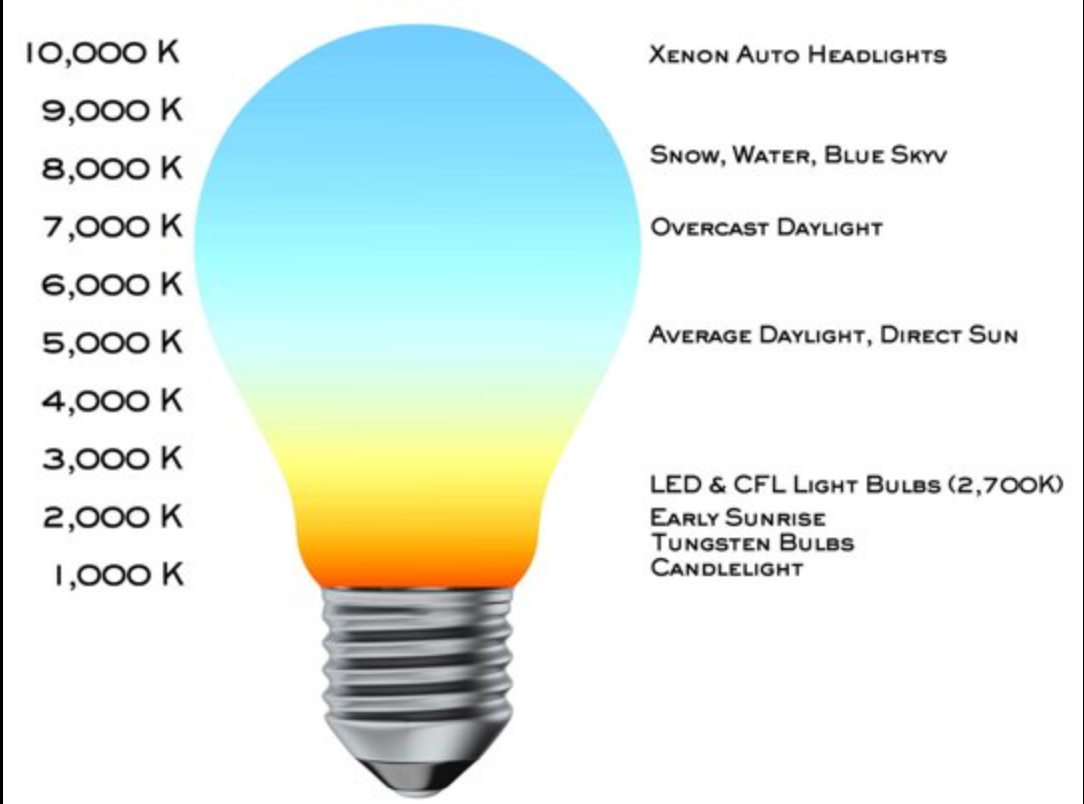Written by Hayden de M. Yates
When selecting the color for your light bulbs I suggest two rules to follow. One, have a clear MOTIVE, and two be CONSISTENT.
When shopping for bulbs, it can be both an overwhelming and confusing task. There is so much information out there, sometimes conflicting, that there is no simple standard to follow. As a home seller, choosing the right color bulbs will determine how your home will look and feel to the buyer. Choosing the right bulb to use will be determined by what your MOTIVE is when lighting the space. When it comes to the interior spaces of a home, lighting can serve two functions. One is to bring light and comfort to a space and home that is being lived in. Two, light can best represent and highlight the best and unique qualities of a particular space or spaces inside a house that is either being sold or advertised.
First, let’s talk about the color of your household bulbs. The two main questions that immediately come to mind are: How many types of bulbs are there? What’s the ideal color to use when it comes to selling a house?
Let’s tackle the first question. Of all of the numerous adjectives used out there to denote the color of our household bulbs, there are 3 we use regularly in our common vernacular; ‘Warm’, ‘Neutral’ or ‘Cool’. ‘Warm’ denotes an amberish (Orange) color, while ‘Cool’ denotes a more blueish (Blue) color, and ‘Neutral’ emits no color at all (White).
However, when I look up the term ‘white bulbs’ on Google, I actually found 5 or more types of white bulbs, which incidently each emit a different color other than white: ‘warm white’, ‘soft white’, ‘bright white’, ‘cool white’, ‘daylight’ and so on. When you actually walk into a store like Target or Lowes, you will usually find a lightbulb section that offers all sizes, shapes, and yes, color. So how do I decide which ‘white bulb’ color to use?
After taking 1000’s of pictures of homes for sale or rent, as a professional real estate photographer, I have come to use only two types of ‘white’ household bulbs: ‘soft white’ and ‘daylight’ for my pictures. If you can’t remember which ‘white’ bulb to use, you can also identify the bulb by its ‘color temperature’, a four-digit number followed by the letter “K”, usually stamped on the bulb itself as well as on the box it came in. A ‘Soft White’ bulb, is not actually white, instead it emits an amberish color, and has a color temperature of 2700˚K, while a daylight bulb, which emits a neutral white light has a color temperature of 5000˚K. A 2700˚K bulb emits the same color has the sun when it is setting or rising above the horizon or an old-fashioned Edison incandescent tungsten bulb. A 5000˚K ‘daylight’ bulb emits the same kind of light the sun emits in the middle of the day without clouds. Furthermore, because the color of a ‘daylight‘ bulb is neutral, any color that you use for decor or wall color will be represented more accurately in your home staging and photos.
Natural Light from windows is neutral. (Staged by Lynne Rhea of MomBo Interiors)
Natural Light with indoor ‘Soft White’ (Warm) lighting. (Staging by Lynne Rhea of MomBo Interiors)
As a home seller, whether you’re the property owner or the realtor, I imagine you would want to show off the interior lighting of the house, as a way to insure the potential buyer the electricity in the house is working well. More importantly, it is a way to highlight the unique architectural features of the house that make it more marketable, more salable.
I will say this first. There is NO one exclusive way to light your house. It all depends on the following three factors:
1. Quantity of Natural Light
2. Direction of Natural Light
3. Spacial Staging or Design
The amount and size of windows will determine the amount of natural light that can enter the space. The architectural design of the house in terms of window placement will determine the direction from which the natural light is coming into the space, and the staging or placement of furniture will determine whether to add more interior light fixtures. All of these factors will ultimately determine how you show and/or photograph your space.
Remember the two rules I mentioned at the beginning?
Have a clear MOTIVE
and
Be CONSISTENT
***
“Know your Motive.”
When I am staging a house to sell, and I bring in furniture and colorful accessories to add more visual interest to the various spaces, I prefer to use 5000˚K daylight lighting to show off a house as well as my staging. What I love about this light temperature is because it emits a neutral white, it doesn’t change any of the colors I use for my décor or wall colors. It also closely matches the natural light that comes through my windows, which in turn bring more natural light into the space.
For instance, if I have a grey couch with blue throw pillows, and I have a table lamp that emits a neutral ‘Daylight’ color, it will NOT alter any of the colors of the furniture and accessories. On the other hand, if I were to use a ‘soft white’ (2700˚K) lighting, which emits an amberish glow, the grey of the couch would become more beige and the blue would turn into a greenish color.
Blue vase with interior ‘Daylight’ neutral lighting.
Blue vase with interior ‘Soft White’ lighting.
I also prefer the daylight lighting when it comes to accurately show off the paint colors of the house, whether the walls are white, grey or beige, or any other color, the daylight color of your lighting will accurately reveal the color differences between your main wall paint, accent colors and trim.
***
“Keep it Consistent”
One general rule I do follow is be consistent with your lighting, especially if the house is being sold as a vacant or occupied house. That means try to color match all of the bulbs throughout the house, whether its ceiling fixtures or fixtures in the bathrooms or table lamps. So, whether you choose the 2700˚K ‘soft white bulbs’ or 5000˚K daylight bulbs, be consistent.
The only caveat I have about mixing some 2700˚K soft lighting along with 5000˚K daylight lighting, is when I want to show off some of the lighting fixtures in your staging or design, and show some spots of warm color in a predominantly white or neutral colored room to give it some mood and life.
***
“There’s Always an Exception to the Rule.”
All of what I’ve said so far mostly applies to how you as a seller, homeowner or realtor, would effectively show a house in its best possible light for the purpose of showcasing a house to sell. On the other hand, if my sole intent or motive is to live in the space, I would prefer utilizing 2700˚K soft white lighting for all or most of my fixtures, because of its warmth and lower energy level, because it is ‘easier‘ on the eyes.
Selectively utilizing ‘Warm White’ bulbs with ‘Daylight’ neutral lighting helps bring life into the space (Staging by Lynne Rhea of MomBo Interiors.
However, I would use reserve and caution when utilizing 5000˚K lighting for my own personal living environment. The bulb emits a higher energy light wave, which may affect you emotionally and psychologically. See the following article:
Blue/white light makes us energetic and can interrupt sleep patterns if exposed to around bedtime due to the fact that blue light suppresses melatonin levels. Brain cells tend to be the most sensitive to blue wavelengths and the least sensitive to red wavelengths. Blue wavelengths can even have an impact on those who are blind when it comes to circadian rhythms.
Red/amber light is the least likely hue of light to impact our internal clocks. Red light in the evening can help improve mental health. This is because red light in the evening helps increase the secretion of melatonin which leads to better sleep at night. Better sleep at night leads to improved cognition and overall mental well being.
I hope I was able to clarify some of the confusion surrounding the use of household light bulbs when it comes to showing and photographing real estate. Feel free to contact me with any questions you may have about how to better visually represent your home to sell.
Hayden is a long standing board member of the local real estate staging community in Austin for both RESA and IAHSP. Before Covid-19, Hayden conducted photography workshops around the country for the Real Estate, Design and Home Staging Professional, and now conducts his own group and one-on-one courses online. He also has a cool instructional video on YouTube you might like to explore.
As a filmmaker, he has been involved in film productions in Paris, Los Angeles, Honolulu and Austin for over 20 years. He has also taught Digital Film Production full time at the Art Institute of Austin. Hayden recently released his first feature documentary film A Force in Nature: Jóhann Eyfells, which gained recognition at several film festivals, including "Best Doc" at the Hill Country Film Festival in Texas and DIY Film Fest in Santa Monica, CA, and is currently showing on network TV in Iceland.






